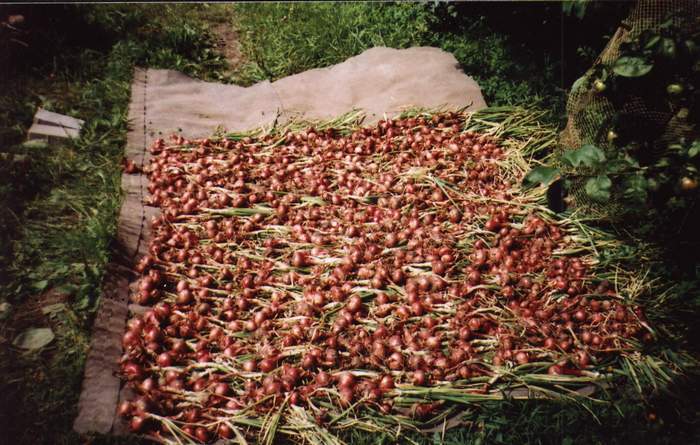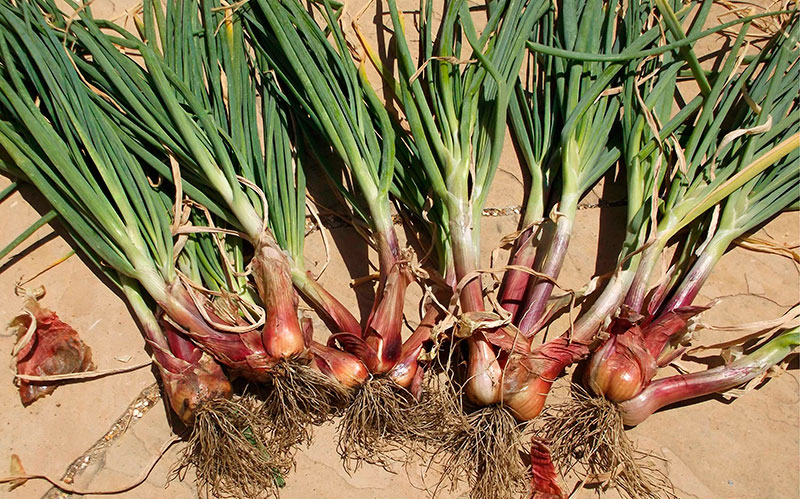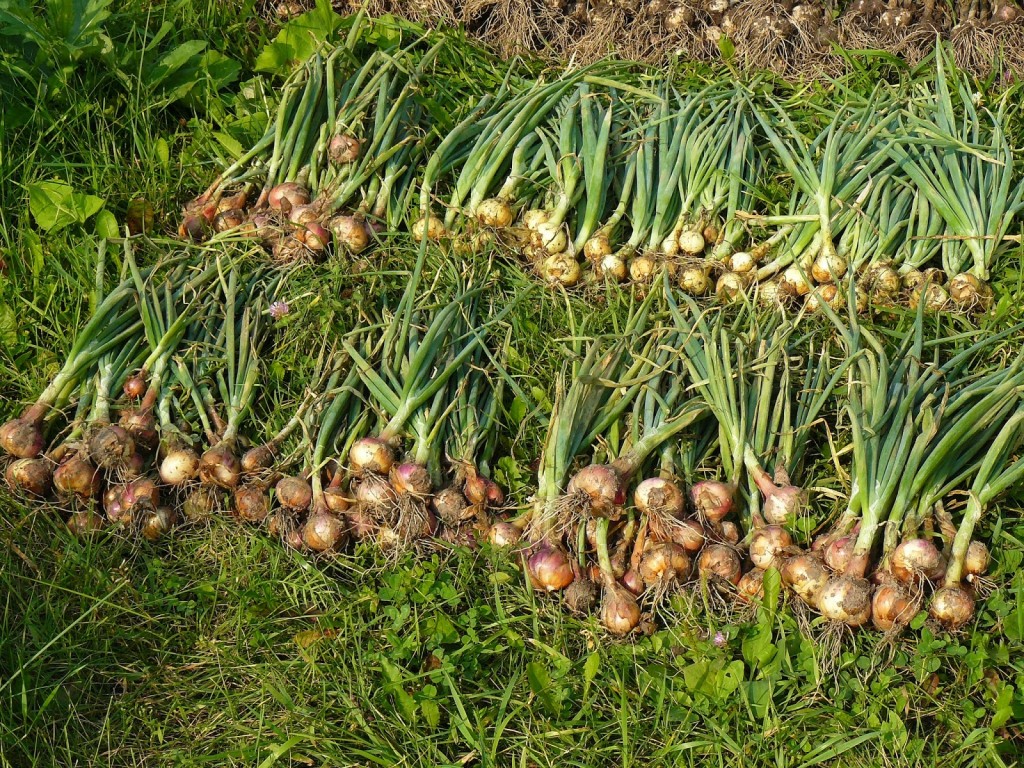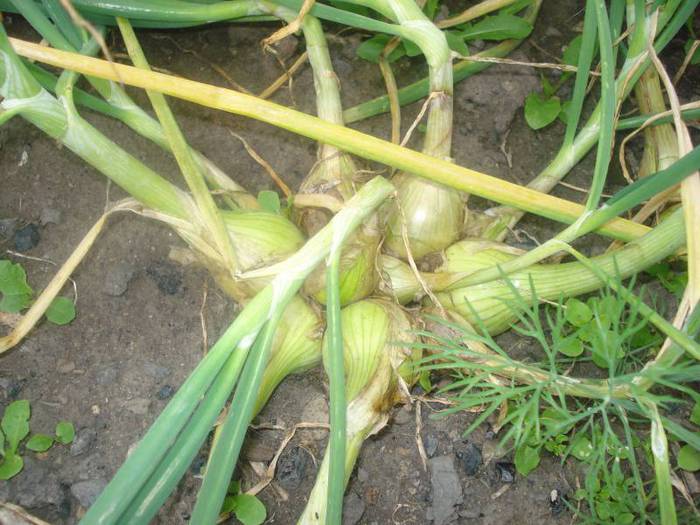Growing and breeding family onions
Content
How to grow
It is customary to grow family onions in a couple of dozen in each nest, where there are about 3-10 bulbs, sometimes their number is close to 20. Moreover, each of them can weigh up to 40 grams. If we talk about the feathers of the family onions, then outwardly they do not look like the feathers of other varieties of onions.
They are visually not only covered with a characteristic beautiful waxy coating, but also less sharp and thinner than other onions. Why do many gardeners prefer to grow this wonderful vegetable at their dacha? This is due to its small onions, which show a good degree of keeping quality, and are also quite capable of becoming an alternative to our long-loved onion, having an excellent taste and smell, and the feather of such a vegetable will not coarsen for a long time.
Growing a family has its own characteristics. Such a vegetable requires for planting the presence of soil with a good drainage system, which also has neutral acidity. Experts call such vegetable crops as carrots, potatoes, and legumes the best predecessors for its cultivation. Autumn soil preparation includes the introduction of humus or compost - about 5 kilograms per square meter. You should also add about 25 grams of superphosphate, 15 grams of potassium salt. Shortly before planting, the land should also be fed with ammonium nitrate in the amount of 7 grams per square meter of usable area. Bulbs can be planted not only with the onset of early spring, but also before winter.
At the same time, it is customary to use such a planting scheme - 15 to 45. A distance of about 20 cm is left between the rows, and up to 10 cm between the bulbs. Please note that if the plant is planted before winter, the harvest should be expected several weeks earlier. The consumption of planting material per square meter is somewhere between 0.75 and 1.5 kilograms. It is recommended to use medium-sized bulbs for planting, and leave very small ones for growing feathers. If you do not really need greens, the family should not be planted very densely.
Crop care
It is customary to harvest the crop when at least half of the feathers wither. Usually this period falls on the end of July. Harvesting too late can reduce the keeping quality as the bulbs begin to develop vigorously. You need to dig it out along with the feathers, and then dry the harvested onion for about 12 days. Lay out the family bow in one layer. For storage, only viable bulbs need to be trimmed and selected. Long-term storage of vegetables is advised in boxes that are located in warm, dry rooms. Shortly before harvesting, you need to stop watering the beds. It is advised to produce it on a sunny day, when you can normally dry the vegetable after digging it up. Also, under open sunlight, the bulbs are disinfected. It takes about a couple of weeks to completely dry the crop.This is best done in a damp-free environment. Pay attention to the condition of the onion neck - just before storage, it should be dry and rather delicate.
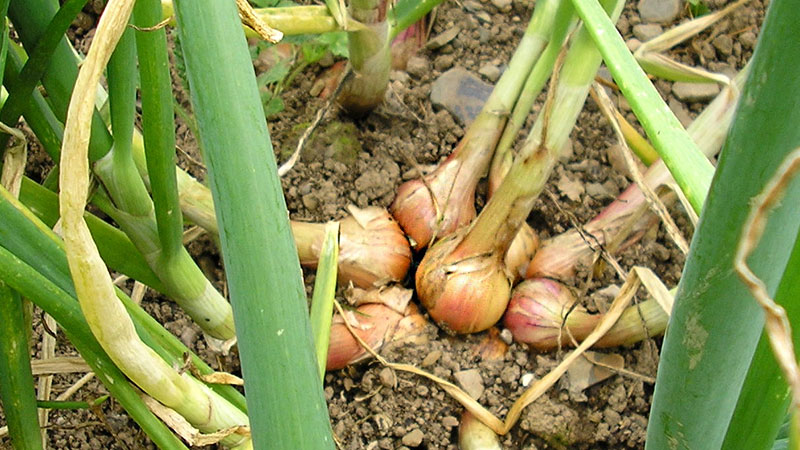 The quality of the harvested crop largely depends on whether you applied the right amount of fertilizing to the soil. Experts advise using manure for these purposes, which is three years old. Loosening of the row spacings is a huge benefit in growing a good harvest of onions. Planting also involves weeding and watering. In addition to manure, the soil should also be enriched with organic fertilizers - infusion of mullein or bird droppings have proven themselves well in this matter. The first should be applied at the rate of 1 in 10, and the second - 1 in 15. For the first time, fertilization is necessary during the intensive growth of leaves, which occurs in early spring. The second time, this is done at the stage of forming the bulbs.
The quality of the harvested crop largely depends on whether you applied the right amount of fertilizing to the soil. Experts advise using manure for these purposes, which is three years old. Loosening of the row spacings is a huge benefit in growing a good harvest of onions. Planting also involves weeding and watering. In addition to manure, the soil should also be enriched with organic fertilizers - infusion of mullein or bird droppings have proven themselves well in this matter. The first should be applied at the rate of 1 in 10, and the second - 1 in 15. For the first time, fertilization is necessary during the intensive growth of leaves, which occurs in early spring. The second time, this is done at the stage of forming the bulbs.
If you plan to grow a family for greens, then harvesting can begin somewhere in the second year of planting a vegetable crop, in the period from mid-April. You need to harvest before the arrows begin to form. At the end of July, drooping feathers must be cut off, and the beds must be well watered. Then, if you also do not forget about loosening when caring for plantings, you can count on long-term good harvests of your favorite vegetable. Planting maintenance also includes hilling the beds, which should be done in August and late November.
To obtain a large onion size, one and a half months after the emergence of shoots, you need to pull out the onion partially, holding the rest of the bulbs with your hand for careful carrying out of this procedure. Since there are a few bulbs left in the nest by the time you start harvesting, they will become large in size.
Video "Turnip onions in my country house"
Types of onions
It is not recommended to grow shallots in one place for many years, since this reduces not only the quantity, but also the quality of the crop. The right choice of onion variety is also of great importance for harvesting a rich harvest. Let's dwell on its three most popular types.
Old Believer
This species comes from the Vologda region of our country. It is characterized by the presence of bulbs that have a beautiful coppery pink color. The name of the onion is due to the fact that Old Believers prefer to use it to treat colds. Such a vegetable is full of substances useful for the human body, and also has a characteristic pungency and pleasant taste. Thanks to all these qualities, such a variety of family onions is very popular among gardeners in our country.
Knyazhich
The peculiarities of this variety are the interesting brown-pink color, the correct oblong shape of the bulbs, as well as excellent taste characteristics. This type of vegetable can be stored for a long time, provided that all conditions are met. When cut, the inside of the bulb reveals a pretty pink flesh. Each onion of the Knyazhich variety can weigh up to 75 grams, and up to 10 pieces can be found in one nest.
Velikoustyugsky
This variety has round-shaped fruits, they not only delight with their brown-red color, but are also quite dense to the touch, give a sharp, pronounced taste. The weight of each of the bulbs reaches an average of 80 grams, and in each nest you can find up to 10 pieces of excellent fruits. Also, this variety is very much appreciated by gardeners for its high yield.
Reproduction
When growing a family on dry land, its plantings begin to degenerate after 12 years. To renew the planting material, onion seed propagation has been used for many years. Seeds are formed on plants whose bulbs weigh more than 60 grams, and the crops themselves are capable of producing at least 4 shooters. The seeds of such onions are larger than those of onions.It is best to plant shallots away from onions to prevent them from crossing. The technique of growing this type of onion is practically the same as that used for onions. Bulbs are also used for propagation.
For the asexual method, you need to prepare the earth in the fall, and in the spring, plant the bulbs, which are well placed in warm water before that. Seeds placed in a gauze bag are advised to put in a plate of water. They are washed every 8 hours and dried before planting. It is also recommended to change the water in the plate. If you follow these simple recommendations, you will definitely be able to get excellent planting material, from which a high-quality onion will grow later.
Video "Planting and harvesting turnip onions"
To know how to properly propagate, plant and harvest turnip onions, we recommend watching the following video.

